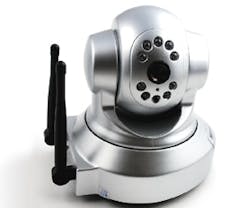As security demands evolve, you need a camera that's flexible enough to meet your building's changing needs. Lemuel Blanco, engineering manager for CPS Security, and Randy Montelius, vice president of engineering for Communications Engineering Company, offer their insights about the advantages of wireless cameras.
BUILDINGS: What are the benefits of wireless cameras?
Blanco: The biggest advantage is the flexibility to place the camera in an optimal location without the limitations, cost, and complexity of running wiring. Wireless cameras can also be relocated to a new location without having to redo any wiring.
Montelius: If you're setting up temporary surveillance to catch a specific incident, that's where wireless really makes sense. A short-term covert surveillance system could easily and quickly be installed while avoiding the expense and disruption of installing permanent cable. The system could then be removed once the necessary data is captured.
BUILDINGS: How do you determine where wireless cameras can be placed in your facility?
Montelius: Look at the difficulty of cable installation. If it's problematic to get cable from wherever your recording equipment is to a particular location, you've got a good candidate for wireless.
Even though they're wireless, the cameras still require power. Therefore, wherever you place them, they still need to be close enough to get 120v power to the camera itself. They also need to be within wireless range of some type of receiver.
Blanco: The effectiveness of the camera will rely on the optimal signal strength of the wireless transmission. Poor signal strength will decrease picture quality. Avoid locations with metal surroundings or under power lines.
BUILDINGS: Is there any difference between using wireless cameras indoors vs. outdoors?
Montelius: Building construction can greatly affect wireless transmission indoors. Steel beam construction reflects transmissions and can alter signal strength and coverage patterns. Existing wireless systems—such as communications, paging, and telemetry systems–can interfere as well.
Blanco: You should consider the elements when mounting a camera outdoors. Avoid placing wireless cameras on metal buildings as metal will cause the signal to reflect. Also avoid going over power lines because the electromagnetic field can reduce the wireless signal.
BUILDINGS: Are there any downsides or considerations to anticipate?
Montelius: When you're going wireless, you'll typically throttle back the bandwidth. You may not get the same frame rate over wireless that you might get with hardwired systems where you'd use the full bandwidth available.
Reducing the frame rate from the real-time rate of 30 frames per second (fps) down to 15 fps is almost unnoticeable and uses half the bandwidth. Most applications operate perfectly well at 8, 4, and sometimes 2 fps.
Blanco: One of the major downsides would be interference from other wireless devices or electromagnetic fields, such as cordless phones. A conflict can be caused if two devices use a similar wireless frequency, canceling each other out.
BUILDINGS: How is interference a potential issue?
Blanco: Metal, walls, and floors will interfere with wireless signals. The closer to these obstructions, the more severe the interference and the weaker the connection or wireless range will be.
Montelius: Wireless is susceptible to interference from many sources, such as other wireless devices, electric motors, and even atmospheric conditions. Providing a strong signal or better wireless coverage can make them less susceptible.
BUILDINGS: Because wireless cameras are susceptible to denial-of-service (DoS) attacks, how can you reduce the likelihood of having your cameras hacked or taken offline?
Montelius: DoS attacks can be difficult to prevent because the airspace around the camera is generally accessible. However, that also means that the attack must be conducted in relatively close proximity to the camera.
This is different than a traditional DoS attack on the host, which could originate from anywhere on the public network. Also consider that most video management systems today can provide alarms or notification if video is lost.
Blanco: Purchase a wireless camera with a built-in firewall and 128-bit encryption, which will make the camera significantly less susceptible.
Jennie Morton ([email protected]) is assistant editor of BUILDINGS.
About the Author
Jennie Morton
A former BUILDINGS editor, Jennie Morton is a freelance writer specializing in commercial architecture, IoT and proptech.
